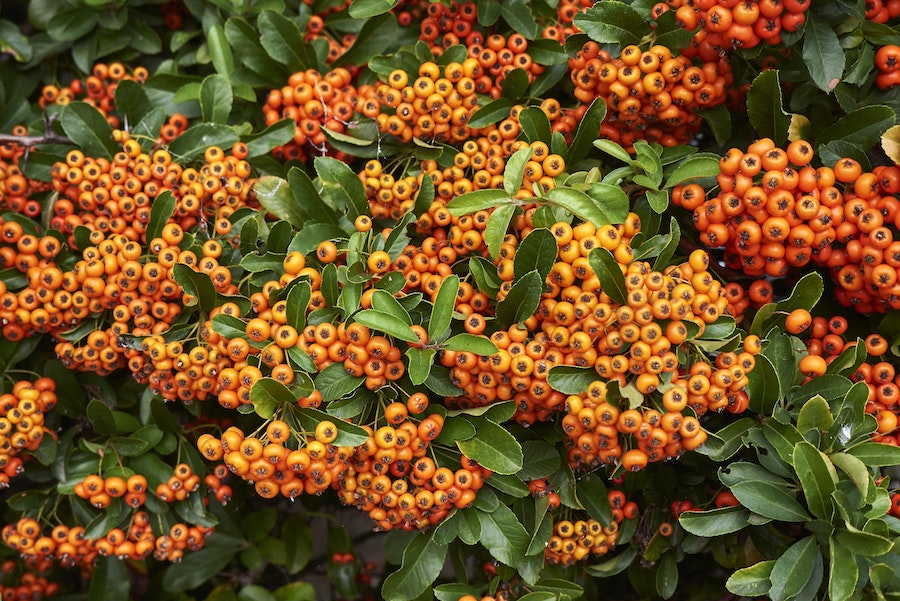No berries on your plants this year? It may be down to the birds and the bees
Look in any garden centre or nursery at the moment and you will see an array of berries in all colours bright and beautiful, from the deep reds of the holly to the wonderful orange-berried cotoneasters.
Yet, many gardeners complain that their shrubs do not produce berries. This may be a problem of gender rather than any disease or weakness in the plant. If you want a sea of berries in your plot, here’s some essential advice.
Plant both male and female holly bushes

Holly needs male and female plants to produce berries
Most varieties of holly carry the male and female flowers on separate plants, so one of each is required for fertilisation to take place. That means you need to grow both male and female plants to pollinate each other.
The female has to have a male nearby to pollinate with. Be careful, though – some of the names are misleading, such as ‘Golden Queen’, which is a male, while ‘Golden King’ and ‘Indian Chief’ are both female.
Look out for self-fertile types
just order a Ilex aquifolium ‘J C Van Tol’ from @ashnurs looking forward to plant later on in the week pic.twitter.com/ReMw2eVHfk
— James Ollier (@JamesGardening) October 22, 2017
But there are varieties that are self-fertile, with male and female flowers, where one plant is therefore capable of producing berries. These include Ilex aquifolium ‘J C van Tol’, which produces bright red berries, and Ilex aquifolium ‘Pyramidalis’, which is similar, but with pale green leaves.
Some female cultivars of holly may produce a few berries even when they are isolated, but for a more reliable crop you’ll need to plant a male nearby.

Most skimmias are not self-fertile
If you’ve only room for one plant, opt for the hermaphrodite S. japonica Subsp. reevesiana, which has both male and female parts.
Trees and shrubs that bear ornamental fruit without needing two plants include Arbutus unedo, crataegus, malus, sorbus, pyracantha, cotoneaster, euonymus and berberis.
These are the plants that need partners

Gaultheria mucronata needs a partner
For a fabulous display of purple fruits, you need to grow a male variety near Gaultheria mucronata ‘Stag River’.
Other dioecious (those which produce a male and a female plant, requiring one of each to pollinate the fruits) include sea buckthorn (Hippophae rhamnoides), Aucuba japonica and Viburnum davidii.
Another wonderful shrub that also needs both male and female plants to produce its vibrant red berries in autumn and winter is Skimmia japonica.
How can you tell a female from a male plant?

Check the label for plant gender
For a start, look at the label. Plants of different sexes will often be marked Female or Male next to the name of the plant. If you know the cultivar name, you can look up its sex in the RHS Plant Finder.
Leave the flowers alone
To get a profusion of berries and decorative fruits you must leave the flower to develop. For many green-fingered buffs who like their garden to be permanently neat and tidy, this may go against the grain. But, putting up with bedraggled flowers will reap rich rewards later on with fruits for the winter season.
Rose hip tip

Rose hips add colour during the cooler months
Not all roses produce hips but most of them do and some are as spectacular as the flowers themselves. If you want rose hips then you need to leave faded flowers on your rose bushes.
Look out for R. moyesii and its various hybrids, which produce orange hips in the cooler months, while Rosa caudata has flagon-shaped hips and Rosa pimpinellifolia produces rich dark hips in chocolate brown through to black.
The fruit of the hawthorn, called haws, are also beautiful, turning dark red as they ripen – but if you trim a hawthorn hedge before it can flower, you will not have any fruit later on.
You may be lucky
If you only have room for one plant but you have neighbouring gardens with the same species, it may be that a male from a nearby garden will be close enough to pollinate a female in yours.
Keeping birds off your berries

Birds feast on berries
While birds generally go for the red and orange berries on shrubs and trees, dark blue and black berries last longest in the winter garden.

Dark blue and black berries last longer in the winter garden
If you want some deep, dark specimens that will see out the winter, look no further than Mahonia repens, Osmanthus decorus and Daphne pontica. Plant them at the front of the border, so that they won’t be lost in the shade.
The fruits of Malus ‘Red Sentinel’, Malus ‘Golden Hornet’ and Sorbus cashmiriana also tend not to be the birds’ first choice.
Remember that some berries and fruits, such as those of ivy or yew, are poisonous and hazardous to young children.
The Press Association
Latest posts by The Press Association (see all)
- 8 things your feet can tell you about your health - January 8, 2025
- 9 ways to look after your emotional health better in 2025 - January 7, 2025
- EastEnders fans to vote on storyline for the first time in 40th anniversary week - January 7, 2025
- Aldi beats rival Lidl as cheapest supermarket of 2024 - January 6, 2025
- All the benefits of lifting weights beyond bigger muscles - January 6, 2025





















